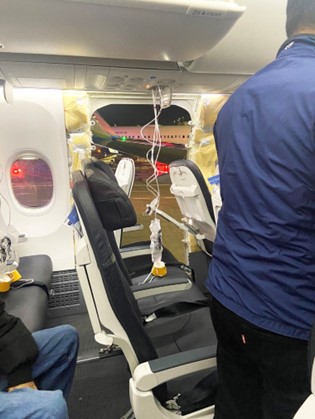The Daily Escape:

Desert sunflowers at dawn in Anza-Borrego SP, CA looking west to the San Ysidro Mountains – January 2024 photo by Paulette Donnellon
Wrongo didn’t expect to again be writing about Boeing’s problems with its MAX aircraft, but here we are. From CNBC:
“The Federal Aviation Administration on Saturday ordered a temporary grounding of dozens of Boeing 737 Max 9 aircraft for inspections, a day after a piece of the aircraft blew out in the middle of an Alaska Airlines flight.”
More:
“…video of Alaska Airlines Flight 1282 that were shared on social media showed a gaping hole on the side of the plane and passengers using oxygen masks before it returned to Portland shortly after taking off for Ontario, California, on Friday afternoon.”
What blew off of the plane is a “door plug”, not a door. The configuration used by Alaska Airlines didn’t require an emergency exit door in that location so Boeing installed a door plug, which is attached to the plane’s skin and covered on the inside so that it appears to be a windowless wall.
Seats adjacent to the blowout were by chance, unoccupied. The accident depressurized the cabin and headrests were detached from two nearby passenger seats, the back of one seat was gone. Here’s a picture taken after the plane landed safely:

Boeing and the Alaska Airlines passengers were very lucky in two respects: First, that no one was sitting in the seats where it happened, and Second, that it didn’t occur at cruising altitude. The sudden depressurization at altitude would have been a disaster with many lives lost.
This happened on a plane that had been in service for just 10 weeks! And it happened a few days after Boeing asked every airline to check their Max-9’s for missing rudder bolts:
“Last month, the company urged airlines to inspect the more than 1,300 delivered Max planes for a possible loose bolt in the rudder-control system. Over the summer, Boeing said a key supplier had improperly drilled holes in a component that helps to maintain cabin pressure.”
And that was only a couple weeks after Boeing asked the FAA to give them a pass on a design flaw in the plane’s engine de-icer.
You remember that this is the plane that Boeing famously mis-programmed to nosedive into the ground. You may have forgotten that Boeing paid a big price:
“In 2021, Boeing agreed to pay more than $2.5 billion to settle a criminal charge related to the crashes. Under the deal, Boeing was ordered to pay a criminal penalty of $243.6 million while $500 million went toward a fund for the families whose loved ones were killed in the crashes. Much of the rest of the settlement was marked off for airlines that had purchased the troubled 737 Max planes.”
These are huge issues with quality and quality control. There are also problems with suppliers. The WSJ reported:
“Fuselage maker Spirit AeroSystems is responsible for installing the emergency-door configuration involved in Friday’s incident. Spirit AeroSystems was working with Boeing on Saturday to determine what went wrong….Spirit AeroSystems was also responsible for the misdrilled holes on the fuselages that disrupted production in 2023.”
Spirit changed CEOs in October 2023, hiring Patrick Shanahan, a 30-year Boeing veteran. Since then, Boeing has invested in and worked more closely with Spirit to address “production” problems.
The Max is the best-selling plane in Boeing’s history. The more than 4,500 outstanding orders for the plane account for more than 76% of Boeing’s order book. Of the nearly three million flights scheduled globally this month, about 5% are planned to be made using a Max, mostly the Max 8.
Wrongo has written about Boeing before and how it lost its culture of engineering prowess and expertise. It began valuing financial engineering over aerospace engineering in 2009-2017 by engaging in $30 billion in stock buybacks, an amount that exceeded its earnings. Then in 2018, buybacks of $9 billion constituted 86% of annual earnings and late in 2018, they approved $20 billion more in buybacks.
Rank capitalism is a big element in this story. Passenger safety has been sacrificed to Wall Street profit-taking and bonuses for Boeing’s shareholders and executives. Until the culture changes back to one focused on engineering, the company will continue to be a hot mess.
Boeing needs a senior management change, and fast, before more people die on their airplanes. Wrongo will certainly avoid flying a 737 Max in the future.
Time to wake up, Boeing! You’re using euphemisms like “production problems” or “supplier problems” to describe improperly drilled holes. There should be no circumstance where a section of the fuselage falls off an airplane in flight. This is systemic, an organization-wide failure.
To help you wake up, watch and listen to Larkin Poe, who Wrongo has featured before, doing a cover of Son House’s “Preachin’ Blues”:
Sample Lyric:
I’m gonna get me some religion
I’m gonna join the Baptist church
Gonna be a preacher
So I don’t have to work



